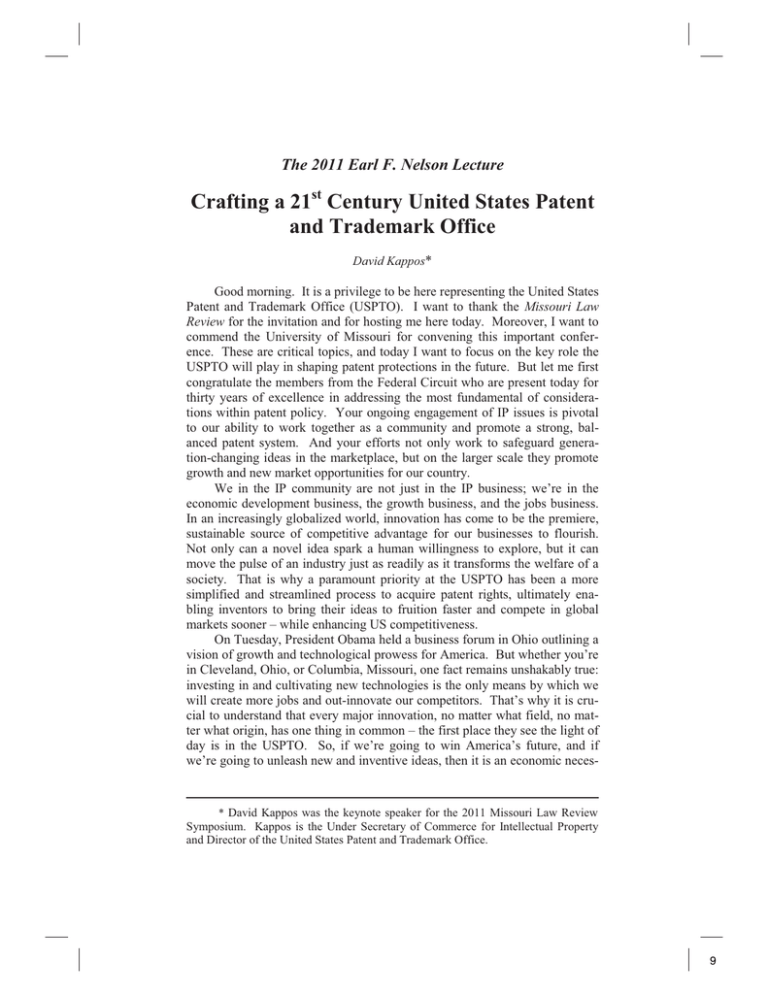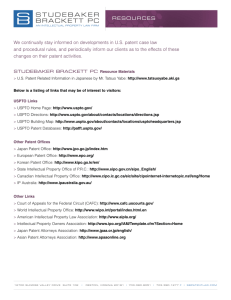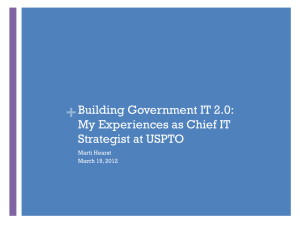Crafting a 21 Century United States Patent and Trademark Office
advertisement

The 2011 Earl F. Nelson Lecture Crafting a 21st Century United States Patent and Trademark Office David Kappos* Good morning. It is a privilege to be here representing the United States Patent and Trademark Office (USPTO). I want to thank the Missouri Law Review for the invitation and for hosting me here today. Moreover, I want to commend the University of Missouri for convening this important conference. These are critical topics, and today I want to focus on the key role the USPTO will play in shaping patent protections in the future. But let me first congratulate the members from the Federal Circuit who are present today for thirty years of excellence in addressing the most fundamental of considerations within patent policy. Your ongoing engagement of IP issues is pivotal to our ability to work together as a community and promote a strong, balanced patent system. And your efforts not only work to safeguard generation-changing ideas in the marketplace, but on the larger scale they promote growth and new market opportunities for our country. We in the IP community are not just in the IP business; we’re in the economic development business, the growth business, and the jobs business. In an increasingly globalized world, innovation has come to be the premiere, sustainable source of competitive advantage for our businesses to flourish. Not only can a novel idea spark a human willingness to explore, but it can move the pulse of an industry just as readily as it transforms the welfare of a society. That is why a paramount priority at the USPTO has been a more simplified and streamlined process to acquire patent rights, ultimately enabling inventors to bring their ideas to fruition faster and compete in global markets sooner – while enhancing US competitiveness. On Tuesday, President Obama held a business forum in Ohio outlining a vision of growth and technological prowess for America. But whether you’re in Cleveland, Ohio, or Columbia, Missouri, one fact remains unshakably true: investing in and cultivating new technologies is the only means by which we will create more jobs and out-innovate our competitors. That’s why it is crucial to understand that every major innovation, no matter what field, no matter what origin, has one thing in common – the first place they see the light of day is in the USPTO. So, if we’re going to win America’s future, and if we’re going to unleash new and inventive ideas, then it is an economic neces- * David Kappos was the keynote speaker for the 2011 Missouri Law Review Symposium. Kappos is the Under Secretary of Commerce for Intellectual Property and Director of the United States Patent and Trademark Office. 9 640 MISSOURI LAW REVIEW [Vol. 76 sity that we win through strong IP right protections and an even stronger Patent and Trademark Office. Through that lens, I want to discuss the strategic vision and future of the USPTO and some initiatives we are working on that are fundamental to realizing a robust patent policy. I also want to take the time to hear from you and answer some questions. Many factors must come together for a nation to pull itself out of a recession. But if we want jobs and businesses to thrive in the United States, we have to invest in cutting edge research and technology. That means building the appropriate infrastructure to bring new products and services to the marketplace as fast as possible. It means unleashing new discoveries in an efficient manner, and it means sparking the imagination of our people. At the end of the day, there is no piece of our long-term economic growth strategy where innovation does not play a role. And that makes IP the bedrock of our nation’s growth. And over the last thirty years the judiciary has played a huge role in laying the groundwork by faithfully shaping the contours of the IP laws – and we sincerely commend the judiciary for that. The Federal Circuit is also proactively reaching out to the IP community and to the USPTO specifically, to solicit amicus briefs and engage in dialogue on key issues in the law. This reflects the superb leadership of the court and we both welcome it and look forward to assisting the court to the fullest extent possible. Between judicial leadership on the bench, our efforts at the USPTO to unleash American innovation, and an increasingly technological world, it’s no question that IP will indeed play a vital role in this generation of American growth and development. U.S. business sectors that rely most heavily on IP protection already account for $5 trillion of gross domestic product, and they employ 18 million workers. This trend will only increase. And it is our job to facilitate – even accelerate – that increase. In order to assist the enterprising inventors that create American jobs, the USPTO must meet the highest standards and be a model to the world for IP administration and protection. We must lead in application pendency, examination quality, IT infrastructure, as well as protection and enforcement of IP rights globally. That’s why we have put together a fantastic team at the USPTO, from our hardworking examiners to our top-level executives; their efforts are essential in advancing America’s IP interests. And to this end, I am proud to inform you that next week we will swear in the new Deputy Director of the USPTO and Deputy Under Secretary of Commerce for IP, Teresa Rea. Teresa brings an enormous wealth of experience and knowledge to the role of Deputy Director. And her past experiences leading the American Intellectual Property Law Association (AIPLA) and serving as a partner with Crowell & Moring give her a unique outlook over the IP landscape. Her leadership will help guide a team grounded in action and will advance ongoing efforts to address the needs of the IP community. Teresa will help us continue working closely with our external stakeholders to develop rules that improve efficiency and effectiveness, reduce pendency, and yield higher quality patents. 2011] CRAFTING A 21ST CENTURY PATENT OFFICE 641 So how are we doing that? Well, it started with our count system. For years, various stakeholders had been urging the USPTO to reform the count system. As you know, that is the system by which we incentivize and measure our examiners. So, shortly after I started at the USPTO, we commissioned a joint labor-management task force to do just that – blow up and redesign the outdated count system. In less than two months, the team delivered on its objective. Specifically, the changes have given examiners more time for a first action on the merits and time for examiner-initiated interviews. The new system has allowed examiners to get it right the first time, and the new system has reduced the credit given for multiple continuing applications. And this new approach has worked: heightening the emphasis on improving quality on the front end of examination and preventing unnecessary re-do work, while also recognizing that continuation practice remains a necessary and important component of the application process in many cases. These changes have improved the quality of examination and given examiners the time and resources they need to make the right decision the first time. This reformed system is helping clear the backlog and meet our goals of reducing pendency. And while we’ve tackled many projects like this to get the USPTO moving in the right direction, there are plenty of challenges ahead. The backlog of nearly 700,000 patent applications is unacceptable; it stifles innovation and restricts the growth of our economy. President Obama and Commerce Secretary Locke understand this and are as dissatisfied with the situation as I am. That’s why Secretary Locke has directed the USPTO to reduce patent pendency on an aggressive schedule. Fixing the pendency problem and clearing the backlog comes down to efficiently identifying and addressing the issues that matter to patentability in each case. We’re addressing this challenge in a variety of ways: putting appropriate incentives in place, improving examiner-applicant communication, reengineering the Office's handling of the examination process more generally, modernizing our IT infrastructure, and increasing work-sharing and harmonization with other patent offices. Let me highlight a couple examples here: In the category of examinerapplicant communications, we have expanded our “first action interview” pilot program. The program improves communication between examiners and applicants during the initial phase of application review. It has proven effective, and everybody in this room should be using it. Statistically, it increases your chances of getting a first action allowance by over 600%. A second example arises in the international context. As many of you are aware, international filings have increased dramatically in recent years. To address this challenge, we must improve our work-sharing capabilities. We are making real progress with our cross-border programs that enable the USPTO to double up on the efforts of our overseas partner offices. The Patent Prosecution Highway (PPH) program is one of our key work-sharing vehicles. This program is designed to increase information sharing between the USPTO and foreign patent offices. By looking at some statistics from our PPH program you can easily gauge its efficacy: 10 642 MISSOURI LAW REVIEW [Vol. 76 First action allowance rates for PPH cases are approximately 22%. That is double the first action allowance rate for international filings that do not use the PPH system. Overall allowance rates for PPH cases are approximately 90%. That’s also about double the USPTO’s overall allowance rate. The average time to first action for a PPH case is about 2 to 3 months from the date of grant of the PPH request. As we all know, that’s off the charts! Clearly, the PPH system cuts pendency and increases efficiency for applicants and the office. But the PPH program is applicant initiated. So we need your help to get involved and request PPH for patent applications filed in two or more countries. But a reduction in pendency means little unless the quality of our review process is not only maintained, but improved. To that end a USPTO task force was jointly convened with the PPAC in late 2009. Its mission was to completely reengineer our quality metrics, which were incomplete and badly back-end loaded. Here again, we reached out for a lot of public input, and we got it. We used the input to develop four new quality metrics, plus a composite metric. We have baselined the new metrics and soon will be reporting a very exhaustive set of quality data on our dashboard. Now let’s turn to trademarks for a moment. I don’t want to leave trademarks out of the discussion. We’re also taking a close look at that operation. We’re working on an ambitious project to modernize our TM IT systems. Our goal is for practitioners to be able to keep dockets online, have real time access to application and registration files, receive reminders and updates from the USPTO, and have web services tailored to a practitioner’s level of expertise. We’ve conducted outreach to the community to learn what functions you would like on the site. And we’re getting the IT resources set in place now to build that project out. In another positive step for trademarks, the Federal Circuit’s decision in In re Bose Corp.1 ended what I thought was a too aggressive and too broad interpretation of fraud on the trademark office. The Federal Circuit gave us good guidance in Bose. Now we need to apply this guidance in the context of our use-based trademark system. As a practical matter, the Office is seeing an increasing number of applications with huge lists of good and services, in both use and intent-to-use cases. Examining attorneys have a limited set of legal and practical tools to deal with such applications. And a use-based trademark system falls apart if the statements of use are unreliable. So our TM management team engaged trademark owners and the trademark bar in discussions on this matter. We’re 1. 580 F.3d 1240 (2009). 2011] CRAFTING A 21ST CENTURY PATENT OFFICE 643 using that insight to develop long-term solutions that work for the Office and the applicant community. Throughout the USPTO, our objectives are ambitious and we cannot achieve them alone. That is why events like this are of utmost importance. They give us a chance to listen to your concerns and ultimately inform us of the best ways to move America forward, one patent at a time. But pivotal to any such discussion, the long-term success of our system is a much needed patent reform effort, and we’re counting on you, in this room, to help us do that. In the past fifty years we have seen more technological advancements than in any period in history but no comprehensive patent reform to keep up with the times. In this new century, we can’t expect tomorrow’s economy to take root in yesterday’s infrastructure. In order to bring ideas to market – in order for twenty-first century ideas to capture funding – we must adopt a system that is fairer, more efficient, and better balanced to inventors of all sizes and in all industries. That’s why I need your support for Senate passage of the Patent Reform Act of 2011.2 It will establish a more sustainable funding model for the PTO so we can insure the highest quality patent reviews. It will reduce the high costs to manufacturers and innovators alike of reviewing and granting IP rights by offering faster and cheaper alternatives to complex and costly litigation. In an increasingly globalized world, the proposed patent reform legislation will also increase USPTO productivity by enabling greater cross-border work-sharing between the USPTO and other patent offices. It will simplify the process of acquiring and securing patent rights for all inventors – both to reduce cost, but to also level the playing field for independent inventors as well as small and large businesses seeking to participate in the global marketplace. And ultimately, it will stream line the system for greater speed and certainty in determining patent rights. That’s why I’ll need all of your support in joining the Obama Administration, the Secretary of Commerce, and myself in making patent reform a top priority, ensuring American vitality. 2. S. 23, 112th Cong. (2011). 11 644 MISSOURI LAW REVIEW [Vol. 76 And we can be honest about it, too. We can openly acknowledge that this bill may be considered a compromise for all and the result of many rounds of negotiations. But at the end of the day, this legislation empowers the USPTO to improve its handling of post-grant challenges; it enables the USPTO to grant higher quality patents swiftly; and it creates a funding model that serves the needs of applicants around the country – all without adding a dime to the deficit. This in turn will empower America’s innovators – the life blood of our economic engine – to move their ideas to market faster, ensuring that our patent system can effectively serve as a springboard for growth. But we need you to continue to engage. We need you to constantly evaluate the system, review the impact of the courts, and continue to hold conferences like these that shine light on important matters impacting the IP community today. We need you to use our Green Technology and other acceleration programs to help us get the MPEP done right. And we need you to join us in supporting patent reform. Enactment of patent reform is vital not only for the PTO but for our country to revitalize our economy, create jobs, and unleash American ideas to out-innovate, out-educate, and out-build the rest of our economic competitors. All the improvements embodied in the patent reform legislation and other strategic efforts outlined here today are essential to winning our future through a winning USPTO. And it is conferences like this that allow us to pause and take notice in assessing the work that is left to do for our country. It is the ideas generated here that will allow us to determine how best to move forward. And it is the gaps that we highlight and the reforms we propose that will prove essential in unleashing America’s creativity around the world. Thank you.


